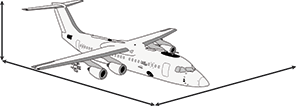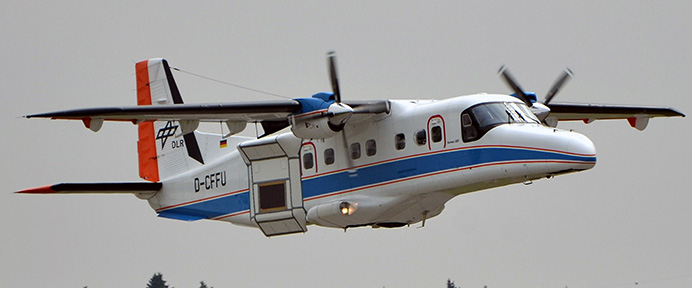Aircraft: DO228-212 - DLR
Dimensions
- Length: 15.04 m
- Height: 4.86 m
- Wingspan: 16.97 m
 15.04 m
4.86 m
16.97 m
15.04 m
4.86 m
16.97 m
Flying performances
Speed| Min speed | 40 m/s |
| Max speed | 100 m/s |
| Usual speed during measurements | 85 m/s |
| Usual speed during transit flights | 100 m/s |
| Ascent rate | 5 m/s |
| Min altitude |
|
| Max ceiling | 25 000 ft |
| Usual ceiling during measurements | 20 000 ft |
| Ceiling limitations | Data Sheet LBA (German Aviation Authority) |
| Empty weight | 4 002 kg |
| Max take-off weight | 6 575 kg |
| Max payload | 1 233 kg |
| Max scientific payload | 1 157 kg (X-coordinate of 2nd point) |
| Usual scientific payload during measurements | 600 kg |
| Scientific payload for max endurance | 81 kg (X-coordinate of 1st point) |
Endurance
| Max endurance at min scientific payload and max fuel | 7 h (Y-coordinate of 1st point) |
| Endurance at max scientific payload | 4 h (Y-coordinate of 2nd point) |
Range
| Max range | 2 360 km (at min scientific payload and max fuel) |
| Conditions for max range |
n/c |
| Range at max scientific payload | None km |
| Usual range during measurement flight | 440 km |
Other
| Weather conditions limitations |
VFR, IFR, certified for known Icing-Condition |
| Take-off runway length | 730 m |
| Engines | 1 x Honeywell TPE 331-5A-252 D |
| Avionics | Universal UNS 1L,MFD Avidyne EX-500 |
Crew and scientists on board
| Crew (pilots + operators) |
VFR 1 pilot, IFR 2 pilots |
| Seats available for scientists | 19 (pax configuration) |
Cabin
| Length | 6.30 m |
| Width | 1.34 m |
| Height | 1.55 m |
| Apertures | Main door: W1.92 m x H1.55 m |
| Cabin pressurized | no |
| More information | no |
Aircraft modifications
| Nose boom | no |
| Windows | A bubble window with operator location and navigation telescope at the right front-side of the cabin. |
| Openings | Cabin floor: 1 x W2.06 m x L0.52 m and 1 x D0.48 m |
| Hard points | 6 hardpoints in the middle of the fuselage floor for external loads up to 200 kg. It is planned to install a radom for the protection of sensors. |
| Inlets | 4 in total. |
| Additionnal systems | Additional mounting rails for measuring equipment in the cabin. |
Acquisition systems
Onboard data recording system. Telemetrie-link to a ground station on development.
Electrical power
| Aircraft total electrical power (kW) | 18-30 VDC ; 110-120 VAC ; GEN 250 A |
| Electrical power (kW) and voltages (V) available for scientists | 28 VDC - 8.4 kW ; permanent installed 2kW / 220 V / 50 Hz convertor |
